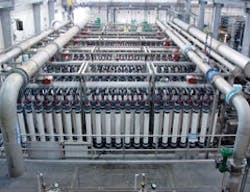Assuring Adequate Potable Water Supplies
Many communities in the water-stressed desert Southwest are turning from over-burdened aquifers to surface water sources for potable water supplies. In 1969, the completion of the DeCordova Bend Dam on the Brazos River formed Lake Granbury, and the lake now provides a surface water alternative to over-burdened aquifers.
Because of increasing demand, BRA saw a need to upgrade and expand the SWATS plant. The scope of the project focused on enhancements to the ultrafiltration (UF) system used to provide high-quality pre-filtered surface water as feed to an existing RO system. Once completed, the UF upgrade would increase the overall plant capacity.
To perform the SWATS upgrade, BRA selected Layne Christensen Company’s Membrane Technology Group . Layne Christensen was selected for the project based on its ability to provide the comprehensive engineering, programming, manufacturing and construction services needed to successfully complete the project. All new equipment was fabricated at Layne’s manufacturing facility in Lakeland, Fla. The supervising engineer was NRS Engineers. Layne’s district manager is Randy Hagen and Layne’s Brendan Kranzmann served as project manager during the upgrade.
During treatment, raw water is pumped from Lake Granbury to a clarifier, followed by recarbonation with carbon dioxide. It is then directed to either a 7.5-million-gal-per-day (gpd) sand filter or to the membrane building. Once in the membrane building, all of the clarified water is treated by the UF system. The UF product water is then processed by a 7.5-mgd RO system. Any excess UF product water is delivered to finished water storage for direct use in the distribution network.
The project began in August 2006 and was substantially complete by October 2007. Layne fulfilled the upgrade by building and installing a 1.8-mgd UF skid using vertically mounted Norit X-Flow membranes. The additional skid increased the overall UF system capacity from 7.3 to 9.1 mgd. Eighty membrane modules are used in each of five UF trains. Once the initial expansion was completed, the existing trains were retrofitted with vertically mounted Norit X-Flow membrane modules. The new UF train was used to take the production load off the original trains and to allow easy retrofit without interruption to the Brazos River Authority’s customers during the transition.
The retrofit of the existing UF trains was accomplished onsite as a construction retrofit project. Operational changes included replacing valves to reduce water hammer issues, engineering changes to the backwash system and control programming changes to the existing control system to optimize the system performance.
The control upgrades were performed by Layne personnel, with Alex Barr of the Membrane Technology Group taking the lead. Among the upgrades were installation of the Watereye remote data collection and monitoring service, which allowed all parties involved to observe system operation and performance throughout the retrofit and subsequent testing activities. Additionally, Layne upgraded the PLC network to an Ethernet format and installed a VPN to allow remote access to the system SCADA and all PLCs in the UF system. This feature allowed Layne to support the customer with troubleshooting and system adjustments on a virtually instantaneous basis, 24 hours a day.
